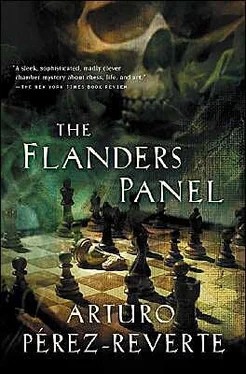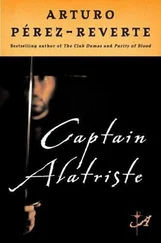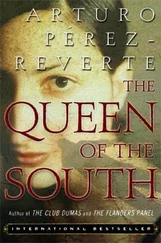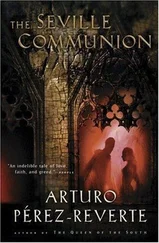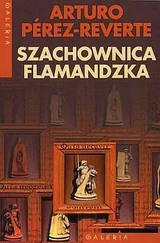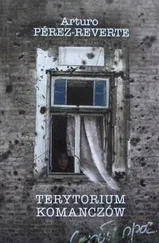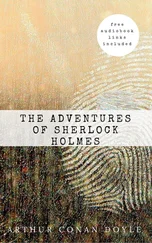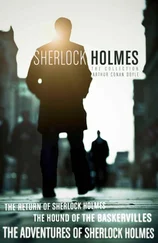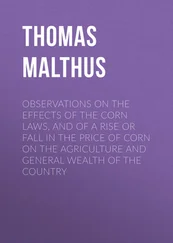She knelt down in front of the painting and peered through the magnifying glass at the chess pieces on the board and on the table. She also looked carefully at the round convex mirror on the wall in the upper left-hand corner of the painting, which reflected the board and the foreshortened figures of both players, distorted by perspective.
“Cesar.”
“Yes, love.”
“How many pieces are there in a game of chess?”
“Urn… two times eight, so that’s sixteen of each colour, which, if I’m not mistaken, makes thirty-two.”
Julia counted with one finger.
“The thirty-two pieces are all there. You can see them really clearly: pawns, kings, queens and knights… Some on the board, others on the table.”
“Those will be the pieces that have already been taken.” Cesar had knelt down by her and was pointing to one of the pieces not on the board, the one Ferdinand of Ostenburg was holding between his fingers. “One knight’s been taken; only one. A white knight. The other three, one white and two black, are still in the game. So the Quis necavit equitem must refer to that one.”
“But who took it?”
Cesar frowned.
“That, my dear, is the crux of the matter,” he said, smiling exactly as he used to when she was a little girl sitting on his knee. “We’ve already found out a lot of things: who plucked the chicken and who cooked it. But we still don’t know who the villain was who ate it.”
“You haven’t answered my question.”
“I don’t always have brilliant answers to hand.”
“You used to.”
“Ah, but then I could lie.” He looked at her tenderly. “You’ve grown up now and are not so easily deceived.”
Julia put a hand on his shoulder, as she used to when, fifteen years before, she’d ask him to invent for her the story of a painting or a piece of porcelain. There was an echo of childish supplication in her voice.
“But I need to know, Cesar.”
“The auction’s in less than two months,” said Menchu. “There’s not much time.”
“To hell with the auction,” said Julia. She was looking at Cesar as if he held the solution in his hands. Cesar gave another slow sigh and brushed lightly at the carpet before sitting down on it, folding his hands on his knees. His brow was furrowed and he was biting the tip of his tongue, as he always did when he was thinking hard.
“We have some clues to begin with,” he said after a while. “But having the clues isn’t enough; what’s important is how we use them.” He looked at the convex mirror in the painting, in which both the players and the board were reflected. “We’re used to believing that any object and its mirror image contain the same reality, but it’s not true.” He pointed at the painted mirror. “See? We can tell at a glance that the image has been reversed. The meaning of the game on the chessboard is also reversed, and that’s how it appears in the mirror as well.”
“You’re giving me a terrible headache,” moaned Menchu. “This is all too complex for my feeble encephalogram. I’m going to get myself a drink.” She poured herself a generous measure of Julia’s vodka, but before picking up the glass, she took out of her pocket a smooth polished piece of onyx, a silver tube and a small box, and set about preparing a thin line of cocaine. “The pharmacy’s open. Anyone interested?”
No one answered. Cesar seemed absorbed in the painting, indifferent to everything else, and Julia merely gave a disapproving frown. With a shrug, Menchu bent over and took two short, sharp sniffs. She was smiling when she stood up, and the blue of her eyes seemed more luminous and absent.
Cesar moved closer to the Van Huys, taking Julia by the arm, as if advising her to ignore Menchu.
“We’ve already fallen into the trap,” he said, as if only he and Julia were in the room, “of thinking that one thing in the picture could be real, whereas another might not be. The people and the board appear in the picture twice, once in a way that is somehow less real than the other. Do you understand? Accepting that fact forces us to place ourselves inside the room, to blur the boundaries between what is real and what is painted. The only way of avoiding that would be to distance ourselves enough to see only areas of colour and chessmen. But there are too many inversions in between.”
Julia looked at the painting and then, turning round, pointed to the Venetian mirror hanging on the wall on the other side of the studio.
“Not necessarily,” she replied. “If we use another mirror to look at the painting, perhaps we can reconstruct the original image.”
Cesar gave her a long look, silently considering her suggestion.
“That’s very true,” he said at last, and his approval was translated into a smile of relief. “But I fear, Princess, that both paintings and mirrors create worlds that contain too many inconsistencies. They’re amusing perhaps to look at from the outside, but not at all comfortable to inhabit. For that we need a specialist; someone capable of seeing the picture differently from us. And I think I know where to find him.”
The following morning, Julia telephoned Alvaro, but there was no answer. She had no luck when she tried to phone him at home either, so she put on a Lester Bowie record, started the coffee, stood under the shower for a long time and then smoked a couple of cigarettes. With her hair still wet and wearing only an old sweater, she drank the coffee and set to work on the painting.
The first phase of restoration involved removing the original layer of varnish. The painter, no doubt anxious to protect his work from the damp of cold northern winters, had used a greasy varnish, dissolved in linseed oil. It was the correct solution, but over a period of five hundred years no one, not even a master like Pieter Van Huys, could have prevented it from yellowing and thereby dimming the brilliance of the original colours.
Julia, who had tested several solvents in one corner of the painting, prepared a mixture and concentrated on the task of softening the varnish by using saturated plugs of cotton wool held between tweezers. With great care, she began working where the paint was thickest, leaving until last the lighter and more delicate areas. She paused frequently to check for traces of colour on the cotton wool, to make sure that she wasn’t removing any of the painted surface beneath the varnish. She worked all morning without a break, stopping for a few moments every now and then to look at the painting through half-closed eyes to judge how things were progressing. Gradually, as the old varnish disappeared, the painting began to recover the magic of its original pigments, most of which were almost exactly like those the old Flemish master had mixed on his palette: sienna, copper green, white lead, ultramarine… With reverential respect, as if the most intimate mystery of art and life were being revealed to her, Julia watched as the marvellous work came to life again beneath her fingers.
At midday, she phoned Cesar, and they arranged to meet that evening. Julia took advantage of the interruption to heat a pizza. She made more coffee and ate sitting on the sofa, looking closely at the craqueiure that the ageing process, exposure to light and movement of the wooden support had inevitably inflicted on the painted surface. It was particularly noticeable in the flesh tints and in the white-lead colours, less obvious in the darker tones and the blacks. That was especially true of Beatrice of Burgundy’s dress, which seemed so real Julia felt that, if she ran her finger over it, it would have the softness of velvet.
It was odd, she thought, how quickly modern paintings became crisscrossed with cracks, often soon after they were finished, the craqueiure and blistering being caused by the use of modern materials or artificial drying methods, whereas the work of the old masters, who took almost obsessive care, using skilled techniques of preservation, resisted the passage of the centuries with far greater dignity and beauty. At that moment, Julia felt intense sympathy for old, conscientious Pieter Van Huys, whom she imagined in his medieval studio, mixing clays and experimenting with oils, in search of the exact shade he needed for a glaze, driven by the desire to set the seal of eternity on his work, beyond his own death and the death of those he depicted on that modest oak panel.
Читать дальше
